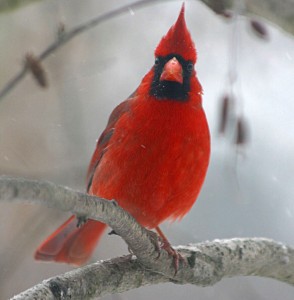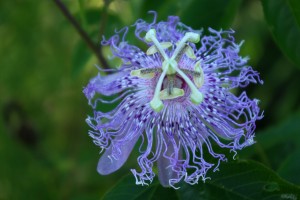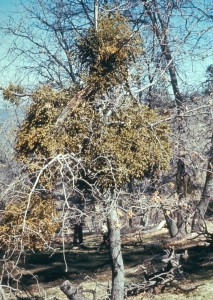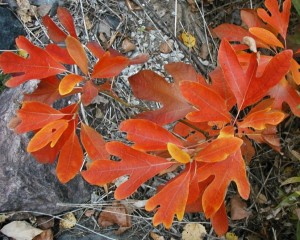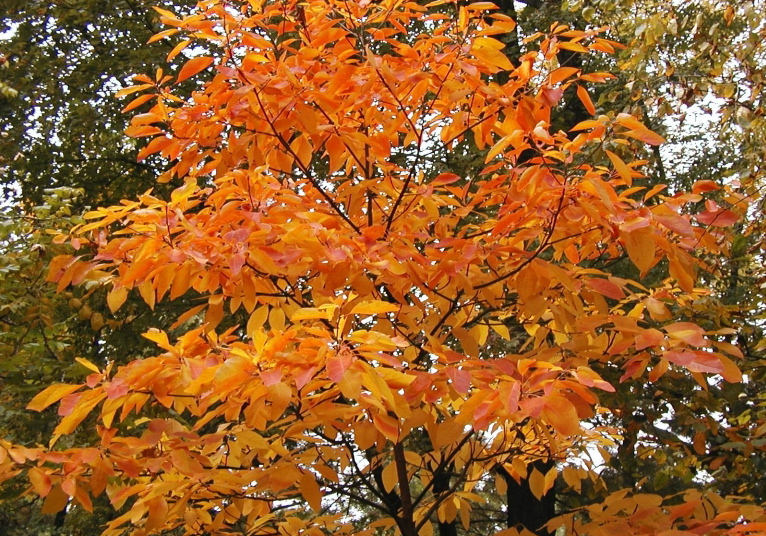The Nature of Holiday Traditions
Much of the upcoming holiday season’s traditions are based on customs brought from the past and honored in the present. Of these, perhaps the most potent are those that remind us of our connections with the natural world and the evergreen assurance that even in winter’s desolate landscape of still quiet, life and warmth will return. Several species within our bluff lands are living links and symbols to connect both the natural world and the traditions and beliefs we celebrate during Yuletide.
Even as they symbolize both beauty and living warmth perched on a snow-covered branch as depicted on many a holiday greeting card, our beautiful Northern Cardinals carry a name imbued with religious significance in our culture. The Latin root “carde” means “hinge,” and illustrates the important nature of decision making within the hierarchy of the Catholic Church. Because of the cardinals’ importance in making the decisions on which church policy hinged, a brilliant red color was designated for the robes and caps worn by these princes of the church. The 18th century Swedish botanist and “Father of Taxonomy,” Carl Linnaeus thought the feathers of the male Northern Cardinal so resembled the red robes of cardinals that he chose this name for the species. Other peoples have different traditional explanations for “cardinal red.”
Members of the Cherokee Indian tribe related a story that male cardinals received their beautiful plumage as a reward for helping. In their tale, a wolf, worn out and frustrated after enduring several tricks played on him by a raccoon, laid down near a stream. While he slept his tormentor the raccoon daubed mud over the wolf’s eyes. Much later, when the wolf awoke and could not open his eyes he begged help from the small bird he heard chirping nearby. The kindly bird, which wore a dull brown plumage, easily removed the dried mud by pecking gently with its large bill, and so allowed the wolf to open his eyes and see again. As a reward, the wolf showed the bird a nearby magic pool of bright red color. The excited bird, who had always longed to be beautifully colored rather than dull and dun, jumped into the pool and swam about, keeping only his mouth out of the liquid. He called to his mate — wanting her, too, to be able to sport the beautiful red. But, sadly, by the time she flew to join him, most of the magic color was gone and she had to content herself with only a few splashes of color on her wings, breast and tail.
The bright red coloration of a male Northern Cardinal is one of the primary colors of the Christmas season and a potent symbol of the Passion of Christ. And it is this passion that gives the name to one of our area’s most flamboyantly blooming vines, passionflower, or
Passiflora incarnata, and the less flashy-blooming vine P. lutea. Occasional large sprawls of passionflower vines can be found along Levee Road, and sometimes, vining along trees and shrubs at woodland edges. Also known as “Maypops,” perhaps for their initial annual sprouting in that month, flowers of P. incarnata resemble a lavender-hued earth-bound jellyfish or, perhaps, a temporarily-grounded purple spaceship. The fruits, which are about the size and shape of a small lime with a yellowish skin turning green as it dries, are somewhat seedy, and range in taste from lightly astringent to sweet.
The primary range of this genus of plants is in the New World and the association of them with Christ was an intentional one made by Jesuit priests sent as missionaries to South America in the early 17th century. Noting that the native peoples relished the fruits of these vines, and always seeking ways to blend and mesh their teachings with local practices, the Jesuit missionaries found symbols of the crucifixion in the blossoms. The five stamens were seen as Christ’s wounds; the spiraling tendrils were likened to the whips used for beating; the corona symbolized the cross of thorns; the 10 petals and stamens represented the 10 faithful apostles. Though the plants were completely unknown in the Middle East during the time of Christ, the Jesuits’ stories of these blossoms still echo in the name they chose.
Native Amerindians in our area made poultices of crushed passionflower leaves and vines to aid healing for bruises and cuts. They also brewed a tea from the woody vines and drank it as a calming agent, a use also adopted by early European settlers. Up to World War II, extract from passionflower continued to be listed in medicinal drug formularies as a calmative and relaxant, due to its slightly narcotic effect. And, probably through a misunderstanding of the plant’s name and association with devout missionaries, the passion of passionflower has given it a reputation as an aphrodisiac.
Folklore plays a part in the history and stories told about a classic Christmastime plant. Harkening back to Victorian times, sprigs of mistletoe still are used as Christmas decorations and, in some households, are hung above a doorway where guests are greeted with a kiss. But in the deeper reaches of time Northern European peoples worshipped the little plant that grows high in the boughs of oak trees finding in its evergreen nature a potent symbol of continued life through the long dark days of winter. The first century Roman naturalist Pliny noted that people throughout Gaul (greater Western Europe, today) so venerated mistletoe, particularly the plants growing in oak trees, that only a Druid, “…so they call their wizards……clad in a white robe climbs the tree and with a golden sickle cuts the mistletoe, which is caught in a white cloth.”
Scandinavian mythology tells the story of Balder’s death and the central role of mistletoe. Balder, god of goodness and peace, was the most loved amongst all the gods. His mother worried about him and gained the promise of all natural things to do Balder no harm. To celebrate Balder’s apparent freedom from threat, the other gods amused themselves by attacking him — some cutting, some throwing stones — but nothing harmed the newly invulnerable god. Envious, the mischief-maker Loki closely questioned Balder’s mother and found she had not gained a promise from mistletoe, a small plant, which “seemed too young to swear an oath.” Loki cut some mistletoe and tricked the blind god Hother into throwing it at Balder. The mistletoe pierced him and Balder fell dead.
In later versions of the tale, the gods brought Balder back to life. In celebration, mistletoe was given to the goddess of love for keeping and she decreed that anyone who passes under the plant should receive a kiss — a custom adopted and carried forward by Victorians who included it and mistletoe in their Christmas celebrations.
In our area, American mistletoe (Phoradendron serotinum) grows throughout Southern Illinois. Its scientific name hints at its parasitic nature, for “phoro” is the Greek word for thief and “dendron” translates to tree. And, indeed, mistletoe steals from trees, drawing all sustenance from the trees — primarily oaks and hickories — to which it attaches itself. Mistletoe seeds are transferred to new host trees by birds who eat the small white berries which are coated with a sticky substance. When a bird flies to different trees some of the berries travel along and are dropped. They stick to the bark and, in a few days, small rootlets emerge and begin working their way into the bark, thus enabling the plant to grow and take food from the new host. Native Americans limited their use of mistletoe, taking it as a weak tea and only to stimulate contractions during childbirth. The plant does contain toxins and, since the white berries are a primary part of its Christmas ornament appeal, the Victorian custom of hanging mistletoe high in a doorway should be followed to keep children and pets far from the potentially poisonous plant. But, perhaps, the kissing custom is reward enough!
The German tradition of bringing an evergreen tree into the home to celebrate Christmas was gleefully adopted in much of the English-speaking world. Early German settlers facing the vast grassland till prairies of Illinois could walk under deep pine forests only in a landscape of memories of their native lands. In a land with few trees
and even fewer evergreen pines, the settlers created alternates. Small sassafras trees became the most common Christmas tree substitute, and often were decorated with cotton to make them festive “snow trees.”
Dorothy Brandt of Maeystown, who carries on her family tradition of making sassafras snow trees outlined the craft: a small sassafras is cut and stripped of all leaves. Extra branches, if needed, can be
wired in. Then, Brandt says, she starts with small strips of cotton batting and starts to wrap the tree from the top down. “Traditional cotton works better than polyester, “ Brandt warned, and added that she does not wrap the entire tree, but finds the snow trees more realistic if some of the trunk is left bare. She said that the cedar trees of our area, which could have served as evergreen holiday trees, were rarely used. “The German farmers wanted to keep the trees growing and cedars won’t resprout once cut,” she said. And, Brandt added that the thrifty farmer also recognized and appreciated the valuable springtime labor he saved by cutting and removing these nuisance hedgerow trees in the winter.
A few centuries earlier, sassafras trees were thought to be — far from expendable — a precious resource worth significant commercial investment. The earliest Spanish explorers had learned the incredible curative properties of sassafras from New World “Indians.” Extracts from this plant, particularly the roots, were thought to cure any and all fevers, remedy troubles with the liver or stomach, even cause the lame and crippled to be able move about again. Sassafras became the medicinal rage of 16th century Europe, and British merchants underwrote multi-ship journeys to the New England coast. Packed with diverse trade goods for the native peoples on the outbound journeys, the returning vessels were heavily laden with as much sassafras wood and roots as the sailors could find and cut. But, as the healing properties of sassafras did not live up to its reputation, its commercial value faltered and, finally, faded away.
Early settlers continued to brew “calming teas” from sassafras roots, and extracts were included in cough syrups and candies into modern times. Today, however, sassafras and the volatile oil it contains, “safrole” are banned as flavoring agents due to studies in the 1960s which found that the oil caused cancer in laboratory animals.
While we no longer look to sassafras as a curative, we still may take joy in their exuberant colors during autumn. Indeed, the combination of dark blue-purple fruits on thick red stalks hanging betwixt foliage colored in a range running from pale salmon-pink through deep red and light orange and yellow, makes a sassafras a wonderful sight on a day lit with late fall sun. The thumb-lobed leaves remind us that as the tree loses its glorious foliage, we soon will need to draw on mittens to ward off winter’s cold. The dark freeze of winter thaws and melts in the warmth of the traditions we follow, and the stories we tell of the plants and the landscape of our memories.
Clifftop, a local nonprofit organization, is focused on preserving and protecting area bluff lands.
A version of this article appeared in the December 5 2007 edition of the Monroe County Clarion.
© 2007 all content rights reserved, Clifftop NFP.
Comments are currently closed.

